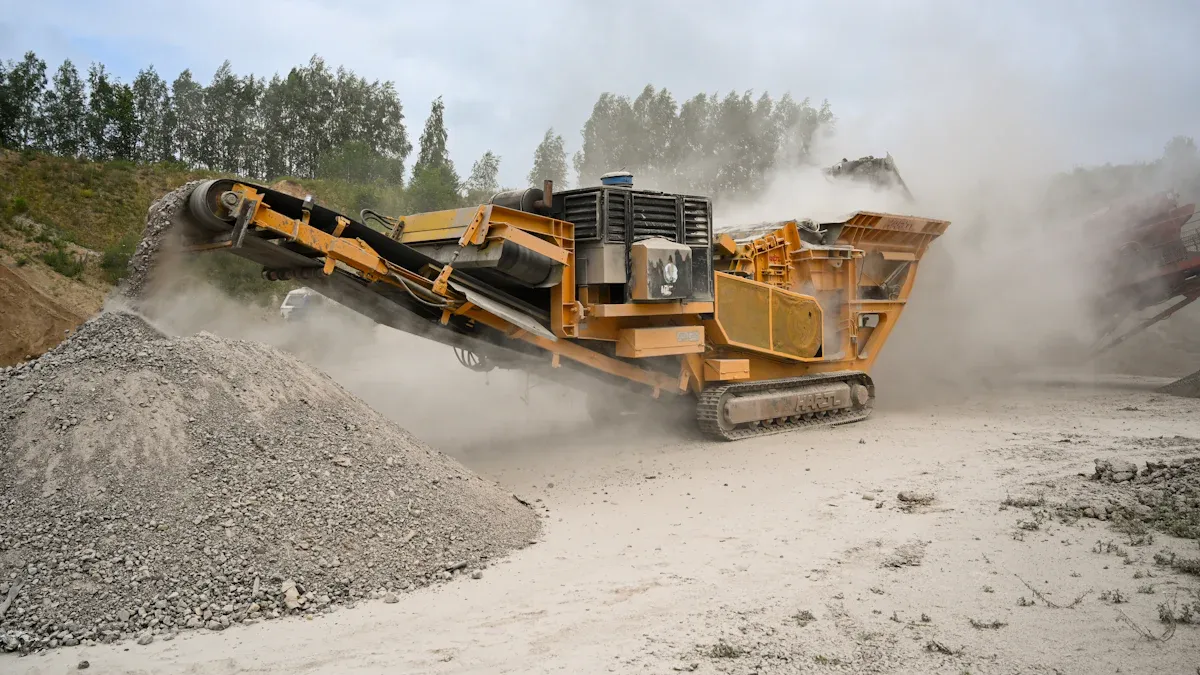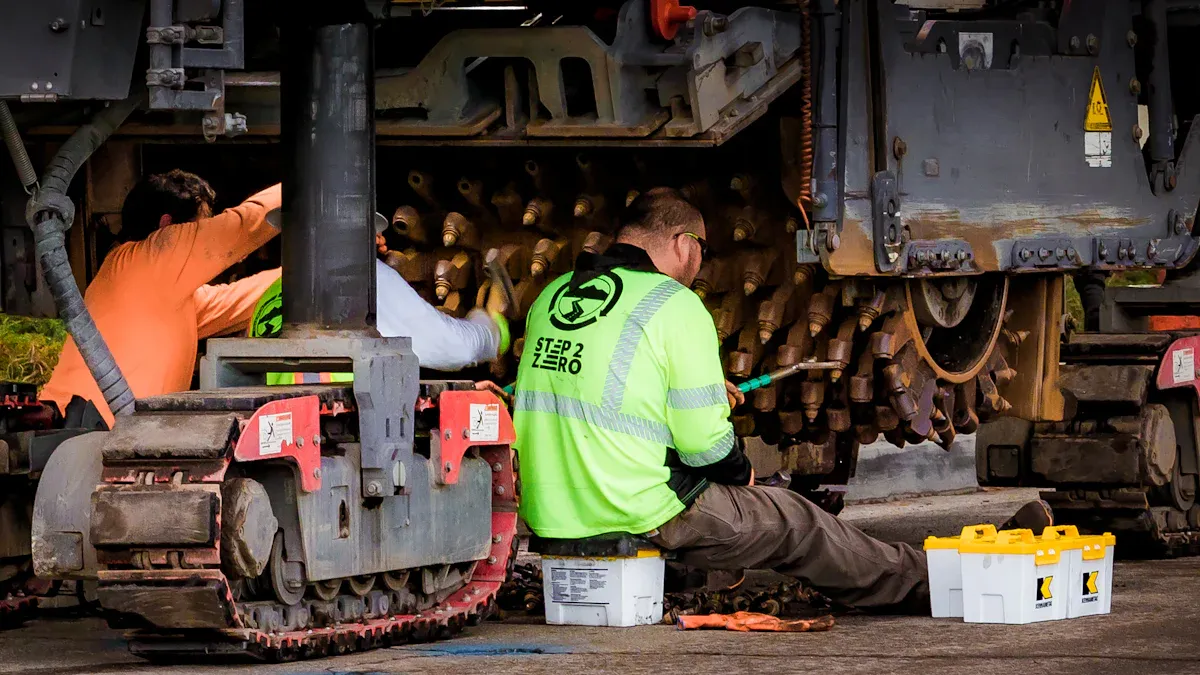
Keeping your cone crusher running efficiently requires more than just routine checks. The right strategies can dramatically extend the lifespan of wear parts, saving you time and money. Material selection plays a vital role in durability. For example, Scott Campbell from Weir Minerals highlights how manganese's work-hardening properties reduce wear and improve performance. Additionally, proactive maintenance and optimized settings can unlock untapped potential in your equipment. By adopting these practices, you can enhance reliability and boost production efficiency, ensuring your operations run smoothly.
Campbell advises replacing mantle and cone liners together to prevent mismatched parts and reduce failure risks. This approach ensures longer-lasting wear parts and consistent performance.

Choosing the right materials for your cone crusher wear parts is essential for achieving durability and efficiency. The materials you select directly impact wear resistance, operational costs, and overall performance. By understanding your crushing applications, balancing material properties, and partnering with reliable suppliers, you can significantly extend the lifespan of your equipment.
Every crushing application is unique, and the material used for wear parts must align with the specific demands of your operation. For example, materials like cemented carbide (WC-10Co) reinforced Ralloy® WR6 have shown exceptional wear resistance in cone crusher conditions. A study revealed that the reinforcement type, size, and distribution significantly influence wear results. However, it also highlighted that traditional dry sand rubber wheel tests do not correlate with cone crusher tests due to differing wear mechanisms.
| Material Type | Wear Resistance | Key Findings |
|---|---|---|
| Cemented Carbide (WC-10Co) Reinforced Ralloy® WR6 | Best wear resistance in cone crusher conditions | Reinforcement type, size, and distribution significantly influence wear results. Dry sand rubber wheel tests do not correlate with cone crusher tests due to different wear mechanisms. |
Matching materials to your crushing application ensures optimal performance and reduces unnecessary wear. For instance, harder materials may be ideal for abrasive rocks, while tougher materials work better for impact-heavy applications. Always evaluate your feed material characteristics and operational requirements before making a decision.
Durability in wear parts depends on striking the right balance between hardness and toughness. Hardness provides resistance to abrasion, while toughness ensures the material can withstand impact without cracking. High-quality spare parts, such as those in the Contender Series, use advanced designs and premium materials to achieve this balance. These components not only extend the lifespan of your cone crusher but also reduce maintenance costs and downtime.
Durable materials help avoid unexpected machinery breakdowns, enhancing operational efficiency.
Extended wear part lifespan maximizes return on investment by delaying major capital expenditures.
Improved designs prevent wear contamination, leading to lower energy and raw material usage.
By selecting materials with the right combination of properties, you can ensure your cone crusher operates efficiently under demanding conditions.
Reliable suppliers play a crucial role in providing high-quality wear parts. Companies like Sandvik have set industry benchmarks by using over 90% recycled raw materials in their cone crusher parts. They also implement buy-back schemes, allowing customers to save up to 40% on recycled parts. These initiatives not only enhance sustainability but also ensure consistent quality.
| Evidence Description | Impact |
|---|---|
| Sandvik's use of over 90% recycled raw material in cone crusher parts | Enhanced sustainability and reduced environmental impact |
| Implementation of a buy-back scheme for wear parts | Customers save up to 40% on recycled parts, incentivizing participation |
| Investment in equipment for regulating batch mixes and identifying steel grades | Ensures high quality of input materials for manufacturing cone crusher parts |
| Life-cycle assessment leading to Environmental Product Declaration (EPD) | Verifies sustainability of products compared to competitors |
| Recognition through Sandvik’s internal Sustainability Award | Highlights the success of circularity initiatives in improving product quality |
Partnering with trusted suppliers ensures you receive wear parts that meet industry standards. These partnerships also provide access to advanced technologies and sustainable practices, which can further enhance the performance and longevity of your equipment.

Regular maintenance is essential to keep your cone crusher operating efficiently and to extend the lifespan of its wear parts. By following a structured maintenance plan, you can prevent costly breakdowns, reduce downtime, and improve overall performance.
Routine inspections are the foundation of effective maintenance. Daily, weekly, and monthly checks help you identify potential issues before they escalate into major problems. For example, daily inspections should include checking hydraulic power units, oil levels, and cooling fans. Weekly checks might focus on wear patterns in the mantle and concave, while monthly inspections could involve examining the drive motor and feed hopper.
| Inspection Type | Description |
|---|---|
| Daily Checks | Inspect hydraulic power units, oil levels, temperatures, cooling fans, and overall noise. |
| 1000-hour Operating Inspection | Review general condition of equipment and key wear components without disassembly. |
| Wear Replacement Inspection | Conduct in-depth inspections of wear parts and other components when replacements are made. |
| Annual Major Inspection | Disassemble and assess the condition of all major components with detailed measurements. |
By adhering to these inspection protocols, you can detect early signs of wear and take corrective action. This proactive approach minimizes unplanned downtime and ensures your cone crusher operates at peak efficiency.
Replacing worn parts before they fail is crucial for maintaining the reliability of your cone crusher. Waiting until a part fails can lead to unplanned downtime, which costs nearly $50,000 per hour in some cases. Regular maintenance can reduce machine failures by 50%, while investing in premium replacement parts can cut downtime by up to 30%.
| Evidence Description | Impact on Downtime/Costs |
|---|---|
| Equipment failures cause unplanned downtime rated at nearly $50,000 an hour. | Highlights the financial impact of downtime. |
| Regular maintenance can reduce machine failures by 50%. | Indicates significant potential cost savings. |
| Investing in premium replacement parts can lead to downtime reductions of up to 30%. | Suggests a direct correlation with reduced costs. |
The Hydrocone crusher, for instance, is designed for easy replacement of worn parts, minimizing disruption to operations. Its lubrication system protects against oil flow failure and overheating, while the Speed-Set control allows quick adjustments to compensate for wear. These features enhance maintenance efficiency and reduce repair costs.
Proper lubrication and cooling are vital for protecting wear parts and ensuring smooth operation. Using the recommended oil and checking levels regularly can prevent overheating and reduce wear. Additionally, monitoring oil distribution to all moving parts ensures consistent performance.
Daily Inspections: Check for unusual noises, oil levels, and leaks.
Weekly Monitoring: Examine wear on the mantle and concave.
Monthly Checks: Inspect the drive motor and feed hopper.
Preventive Maintenance: Schedule regular checks to avoid major breakdowns.
Predictive Maintenance: Use tools like oil temperature sensors and vibration monitoring to track wear.
Benefits: A good maintenance plan maximizes performance and reduces operating costs.
Ignoring lubrication can lead to poor availability and high repair expenses. By implementing proper lubrication techniques, you can extend the lifespan of your cone crusher wear parts and maintain optimal performance.
Properly adjusting your cone crusher settings ensures optimal performance and extends the life of wear parts. Material type and size play a significant role in determining the best configuration. For example, softer materials may require lower crushing forces, while harder materials demand higher pressure to achieve desired results. Aligning the chamber profile with your application needs enhances efficiency and reduces unnecessary wear.
Studies have shown that adapting settings based on material characteristics improves wear part longevity. For instance, research on aluminum alloys highlights how cooling methods and optimized parameters lead to better surface quality and tool life. These f indings emphasize the importance of tailoring your crusher settings to the specific material being processed.
| Study | Findings | Material Characteristics | Method Us ed |
|---|---|---|---|
| Sreejith (2008) | Better wear index and surface quality | AA6061 alloy | MQL, dry, and conventional cooling conditions |
| Abas et al. (2020) | Optimized parameters for best surface quality and tool life | AA6026 alloy | MQL and dry mediums |
By analyzing operational data and material properties, you can make informed adjustments that improve wear part life and overall crusher performance.
Overloading your cone crusher leads to excessive wear and potential equipment damage. Preventing overloading starts with maintaining a proper feed arrangement. Choke feeding ensures the crushing chamber remains full, maximizing multilayer crushing and improving liner wear shape. Monitoring the wear profile of liners helps avoid distorted wear, which can reduce capacity and increase maintenance needs.
Modern hydraulic cone crushers offer advanced overload protection systems. Smart sensors monitor feed rates and bearing temperatures, preventing failures and reducing downtime. These systems also optimize truck unloading processes, ensuring consistent material flow through the crushing stages.
Regular inspections and proactive adjustments further minimize wear. For example:
- Efficient lubrication systems reduce wear on critical component
s.
- Consistent monitoring of wear profiles prevents distorted wear patterns.
- Scheduled maintenance checks identify minor issues before they escalate.
By preventing overloading, you protect your equipment and reduce maintenance costs, ensuring long-term reliability.
Performance monitoring is essential for identifying trends and making timely adjustments to extend wear part life. Advanced systems like H-E Parts' WearVision™ technology provide real-time data on wear liners, enabling precise predictions for liner replacements. These systems generate full wear maps, live wear rate trends, and configurable alarms for increased wear rates.
Metso's automation systems further enhance performance tracking. Sensors monitor feed rates and bearing temperatures, facilitating predictive maintenance. Detailed production reports help you analyze operational data and optimize crusher settings.
Proactive adjustments based on performance data prevent component failures and improve efficiency. For example:
- Detecting decreases in performance allows you to address issues before they escalate.
- Adjusting gap settings based on wear trends ensures consistent crushing results.
- Monitoring oil distribution and temperature prevents overheating and extends part
life.
By leveraging modern monitoring systems, you can optimize your cone crusher's performance and achieve longer-lasting wear parts.
Mastering the three secrets—choosing the right materials, maintaining wear parts regularly, and optimizing crusher settings—can transform your operations. Proactive measures reduce downtime, extend part lifespan, and save costs. For example, a Life Cycle Cost Analysis (LCCA) shows that upfront investments in quality materials and maintenance lead to long-term savings by minimizing production delays and improving reliability.
| Cost Factor | Supplier A (Lower Price) | Supplier B (Higher Price) |
|---|---|---|
| Upfront Material Cost | Lower | Higher |
| Delivery Reliability | Poor | Excellent |
| Production Delays Cost | High | Low |
| Customer Satisfaction Impact | Negative | Positive |
By applying these strategies, you can achieve smoother operations and greater efficiency. Take action today to ensure your cone crusher delivers consistent, reliable performance.
Wear in cone crusher parts often results from improper material selection or overloading. Using the wrong materials for your application or failing to maintain proper feed arrangements can accelerate wear. Regular inspections and adjustments help minimize this issue.
You should inspect wear parts daily, weekly, and monthly. Daily checks focus on oil levels and unusual noises. Weekly inspections examine wear patterns, while monthly checks assess major components like the drive motor. Consistent inspections prevent unexpected failures.
Recycled parts, when sourced from reliable suppliers, maintain high performance. Companies like Sandvik ensure quality by using advanced manufacturing techniques and rigorous testing. These parts also promote sustainability without compromising durability or efficiency.
Proper lubrication reduces friction and prevents overheating, extending the lifespan of wear parts. Use the recommended oil and monitor levels daily. Advanced lubrication systems distribute oil evenly, ensuring consistent performance and reducing maintenance costs.
Optimized settings improve efficiency and extend wear part life. Adjusting settings based on material type and size reduces unnecessary wear. Monitoring performance data helps you make timely adjustments, ensuring consistent crushing results and minimizing downtime.